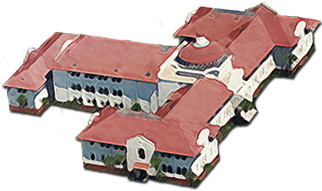Department of Art and Design
http://catalog.valdosta.edu/undergraduate/academic-programs/arts/art/
The Department of Art and Design has four comprehensive undergraduate degree programs and a minor in art. The undergraduate programs include the Bachelor of Fine Arts (BFA) with a major in studio art, the Bachelor of Fine Arts with a major in interior design, the Bachelor of Fine Arts with a major in art education, and the Bachelor of Arts with a major in art. The BFA degrees with majors in art, interior design, and art education are professional degrees. The goal of the professional programs is to develop the knowledge, skills, concepts, and sensitivities essential to the professional life of an artist, designer, or educator, and to prepare students who may be interested in pursuing graduate studies. The program of the Bachelor of Arts (BA) degree with a major in art enables students to develop the range of knowledge, skills, and competencies expected of those holding a liberal arts baccalaureate degree with a major in art and allows the flexibility to design a comprehensive liberal arts curriculum that may include a minor outside of art.
Bachelor of Arts with a Major in Art
http://catalog.valdosta.edu/undergraduate/academic-programs/arts/art/ba-art/
This liberal arts degree with a major in art enables students to develop the range of knowledge, skills, and competencies expected of those holding a liberal arts baccalaureate degree in art. This degree differs from the Bachelor of Fine Arts degrees in that it allows the flexibility to design a comprehensive liberal arts curriculum that may include a minor outside of art.
Bachelor of Arts with a Major in Mathematics
Students will explain and produce mathematical proofs in set theory, algebra, and analysis to indicate that they have acquired the necessary logical reasoning, reading, and writing skills. Students will prove statements, produce examples, and apply the appropriate theoretical results to a given problem to show understanding of various algebraic structures, including, but not limited to, groups, fields, rings, and vector spaces. Students will prove statements, produce examples, and apply the appropriate theoretical results to a given problem to demonstrate understanding of the analytic structure necessary for the classical (real-valued function) calculus and its generalization. Students will synthesize the results and techniques of the major branches of mathematics, demonstrated by presentation of mathematics in written and oral form.
Bachelor of Arts with a Major in French
The ability to listen and to read in French at the advanced level of proficiency, as defined by the American Council on the Teaching of Foreign Languages Proficiency Guidelines. The ability to speak and to write in French at the advanced-low level of proficiency, as defined by the American Council on the Teaching of Foreign Languages Proficiency Guidelines. Knowledge of cultural universals and trends, as well as specific similarities and differences between Francophone and American cultures, including both non-verbal and verbal aspects. Knowledge of major historical events and their role in the development of the Francophone cultures as well as knowledge of the major literary and artistic works of those cultures. The ability to use technology for research purposes and as a means of communication with the various areas of the French-speaking world.
Bachelor of Arts with a Major in History
The Bachelor of Arts program with a major in history has numerous desired outcomes. Examples of the outcomes include the following:
Bachelor of Arts with a Major in Spanish
To demonstrate the ability to listen and to read in Spanish at the advanced level of proficiency, as defined by the American Council on the Teaching of Foreign Languages Proficiency Guidelines. To demonstrate the ability to speak and to write in Spanish at the advanced-low level of proficiency, as defined by the American Council on the Teaching of Foreign Languages Proficiency Guidelines. To demonstrate knowledge of cultural universals and trends as well as specific similarities and differences between Hispanic and American cultures, including both non-verbal and verbal aspects. To demonstrate knowledge of major historical events and their role in the development of the Hispanic cultures as well as knowledge of the major literary and artistic works of those cultures. To demonstrate the ability to use technology for research purposes and as a means of communication with the various areas of the Spanish-speaking world.
Bachelor of Arts with a Major in English
1 All core classes with an ENGL prefix ( ENGL 1101 , ENGL 1102 , ENGL 2060 , ENGL 2080 , ENGL 2111 , ENGL 2112 , and ENGL 2113 ) must be completed with a grade of “C” or better. 2 Student may choose one of the above courses not taken in Area C 3 3 hours will count in Area C if student begins foreign language classwork at the 1001 level.
Bachelor of Arts with a Major in Music
http://catalog.valdosta.edu/undergraduate/academic-programs/arts/music/ba-music/
The Bachelor of Arts degree with a major in music is a 120-hour liberal arts degree program. Students must meet all requirements established by the College of Arts and Sciences and the College of the Arts, including a foreign language sequence. Students may select guided electives outside of music to develop a minor in another discipline.
Bachelor of Arts with a Major in Psychology
Students, in consultation with their advisor, will take an additional series of courses, possibly a minor, that will further differentiate between the B.A. and the B.S. degrees. These electives will also allow for increased skill development that will help the student continue on to a graduate or professional school or to obtain employment in a career not requiring post-baccalaureate training. Although only 39 hours of 3000 and 4000 courses are required by the Board of Regents of the University System of Georgia, the student should not assume the minimum to be the maximum.
Bachelor of Arts with a Major in Biology
http://catalog.valdosta.edu/undergraduate/academic-programs/sciences-mathematics/biology/ba-biology/
The B.A. degree with a major in biology is ideal for students who do not need the extra math, chemistry, and physics requirements that are found in the B.S. degree with a major in biology. For instance, most allied health programs do not require a full year of organic chemistry, calculus, or even physics. Therefore, students pursuing those careers after graduating from VSU may wish to consider this B.A. degree option rather than the B.S. degree.
College of Humanities and Social Sciences
http://catalog.valdosta.edu/undergraduate/academic-programs/humanities-social-sciences/
...Associate of Arts Bachelor of Arts Bachelor of...must be at the 3000-4000 level. Experiential...
Department of History
http://catalog.valdosta.edu/undergraduate/academic-programs/humanities-social-sciences/history/
...to the Bachelor of Arts degree with a...must have completed HIST 3000 with a grade...
Academic Policies and Procedures
http://catalog.valdosta.edu/undergraduate/academic-affairs/academic-policies-procedures/
...hours from courses numbered 3000 or above. Courses...major in music or art B.S. with...
ART 3000. Community Art Education. 3 Hours.
Galleries, museums, community centers, and other community-based locations. Students explore art education concepts such as lesson planning, budgeting, and marketing in community settings with their field experience. Additionally, students will learn about art advocacy, art careers and will create professional portfolio.
ARED 3000. Issues and Trends in Contemporary Art Education. 3 Hours.
Prerequisites: ART 3000 and a minimum GPA of 2.75. The study of curricular frameworks, course content, and pedagogical strategies associated with best practices in the field of Art Education.



